
Saffron has a long history of mystifying people. Its delicate crimson strands were among the most revered goods traded on the Silk Road. Every country that was introduced to saffron quickly became enamored with its floral, honeyed aroma and flavor, and in time it became woven into a multitude of culinary traditions. It was a treasured item, often gifted to royalty and to the wealthy not just for its scent and taste, but because of the vibrant golden hue it gives to everything it touches. And after thousands of years being traded around the world, it remains one of the world’s most expensive spices.
Though it is literally the stuff of legends – it is said that Cleopatra bathed in saffron and milk, and Alexander the Great used saffron to make his blond hair a god-like gold – it is an ingredient that is more approachable than you may think. Costly, yes, but for home cooks willing to invest in a premium ingredient, it’s not that hard to use, and you can find high quality saffron if you know where to look. And the best place to start is by exploring saffron’s history and looking to the cultures who use it the most.


Photos by Heray Spices (left) and Ryan Kober (right)
SAFFRON’S GLOBAL INFLUENCE
Saffron’s influence stretches from India to Europe, appearing in dishes like Indian lamb biryani and Iranian tahdig as well as Spanish paella and French bouillabaisse. Nowadays, Iran is the leading producer of saffron, accounting for about 90% of the world’s saffron supply. But this fragrant spice can also be found growing from the north western Himalayas of the Indian state of Jammu and Kashmir to Essex county in England.
It’s unclear where exactly saffron originates, perhaps because of its prevalence and how long it has been cherished by so many. Some believe that saffron use and cultivation may have started in Greece where there is a place called Krokus, possibly named after the purple Crocus sativus flower from which saffron threads are harvested. Others believe that saffron originally comes from southern Iraq where one of the earliest documentation of saffron depicts ancient Sumerians using it to brew gold-colored beer around 5,000 years ago.
Regardless of its origins, saffron’s prominence in the Persian Empire, which encompassed much of the Middle East, cannot be disputed. “Saffron is the most important ingredient in the Iranian cupboard,” says Chef Behzad Jamshidi. “I don’t remember a dinner or a moment where saffron didn’t end up at our table in some capacity. It’s the way we perfume our rice, we throw it in our teas, we read pages of stories in books that were painted with saffron. Even the Persian carpets under our feet, the fabric was stained with saffron. It is hugely important to me and my culture.”
Jamshidi grew up in an Iranian household in Vancouver, Canada. When he moved to New York he worked in Michelin-starred restaurants and alongside award-winning chefs. As his career progressed, Jamshidi wanted to start a culinary venture that would honor his Persian heritage. He founded and became the Executive Director of Moosh NYC, a community driven hospitality business that specializes in projects and events that share stories through food.

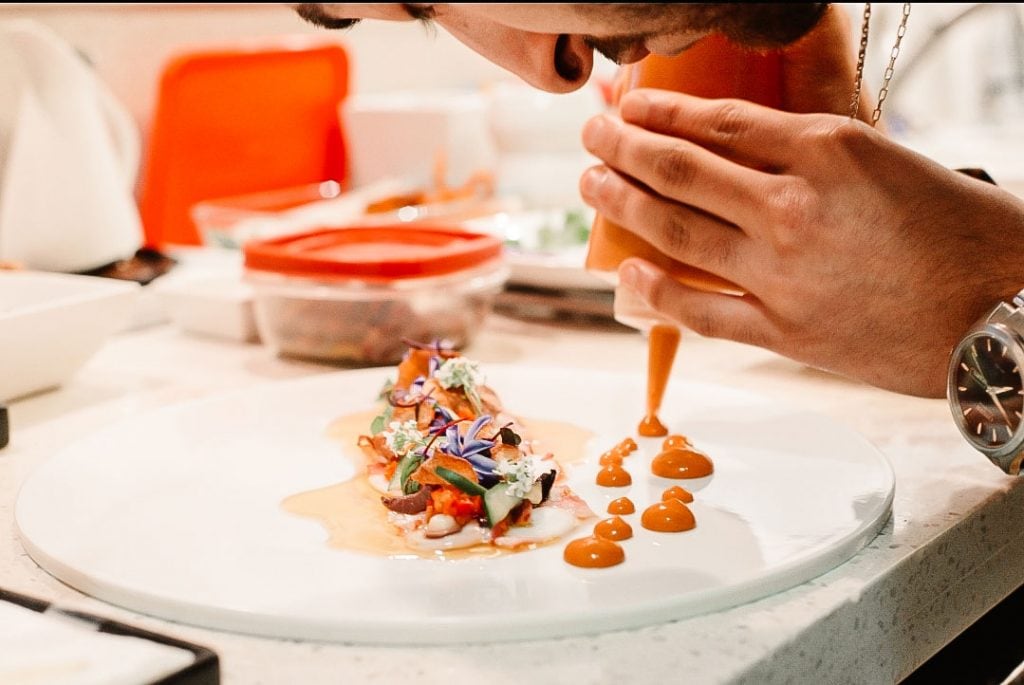
Photos of Nico Schinco (left) and Cody Zimmerman (right)
“The story of Persia and Persian food is that it was a consistent exchange of dialogue with other cultures,” says Jamshidi. At different periods of time both Persepolis and Isfahan, which are located in present day Iran, served as capitals of the Persian Empire. Both cities were important stops along the Silk Road, making them crossroads where goods and cultures were exchanged.
Because so many intersections crossed through Iran, parts of Persian culture can be found across the Mediterranean through Eastern Europe and even into parts of India and East Asia, and vice versa – Jamshidi explains that elements from other cultures have made their way into Persian identity as well, including the Farsi language which has Russian, Arabic, and French mixed into it. Regardless of which direction cultural influences were exchanged, interacting with the Perisan Empire meant also interacting with saffron.
Though India also has stories of being the originator of saffron, some experts believe that saffron was introduced to India by Persian rulers. “We use saffron a lot, especially in dishes inspired by Persian food,” says Kaumudi Marathe, a cookbook author, journalist, food historian and chef specializing in Indian cuisine.
Marathe, who currently works as a Senior Editor with America’s Test Kitchen, has spent about 30 years cooking and researching Indian cuisine. In 2009 she started Un-Curry, a company that focuses on educating people about Indian food through cooking classes. “There really is no such thing as curry,” says Marathe. “The dishes that people are most familiar with – samosas, tandoori chicken, naan – are all from the Punjab. So there’s a lot about Indian food that people just don’t know.”
One traditional dish where Marathe loves to use saffron is lamb biryani, an aromatic dish of seasoned lamb meat layered with basmati rice tinged gold from saffron. Though it has variations throughout India and has become a distinctly Indian dish, the meal can be traced back to Persia’s “birinj biriyani,” which translates literally to fried rice.
Gulab Jamun, a dessert of fried semolina dough balls spiced with cardamom, rose water, and saffron, is another dish likely brought to India by Persians. “Saffron is so delicate,” says Marathe. “I love its delicacy and aroma. And it goes into both savory and sweet foods. I love the versatility that it has.”



Photos by Kae Lani Palmisano
USING SAFFRON
So much of western cooking centers around abundance and the very liberal usage of ingredients. So when it comes to spices like saffron, it’s hard for us to fathom that a small pinch of these delicate threads can transform the flavor of an entire dish. But with all things with great power, a little goes a long way.
“You have to approach saffron in the same way that the people who grew it, harvested it, told its stories and put it into their carpets. You have to touch it in the way that they would touch that ingredient. And we touch it through scarcity” says Jamshidi. “We treat it like it’s the most important thing in the household, and if you’re able to approach it with that kind of delicateness, and be purposeful about where it ends up, I think you can fall in love with it as much as any Iranian has.”
Before using saffron you have to bloom it, which is a simple process that helps bring out the full flavor and potency of the saffron. Jamshidi learned to use saffron from his mother who would grind down a few strands of dried saffron with sugar and coarse salt before steeping it in water. The concentrated mixture creates a tincture often referred to as “Gold Water” in Farsi which can be used right away or kept in your refrigerator for a few days. “The first place I’d say that saffron does its job is in rice,” says Jamshidi. “Having a simple medium that you’re able to stain and perfume saffron with I think is the greatest way to capture it.” Jamshidi also recommends adding a few drops of the saffron tincture as the final touch to whatever you’re cooking.
In addition to water, Marathe likes to use milk to bloom saffron. This works especially well for desserts, including shrikhand, a strained yogurt dessert infused with saffron and seasoned with grated nutmeg, that’s featured in her cookbook, The Essential Marathi Cookbook. Shrikhand literally means “sweet of the Gods” and its creaminess and rich flavors made it a popular dish served at banquets during the 18th century. It’s a culinary tradition with a long history in Maharashtra, the state where Marathe comes from, and the surrounding areas. “I use milk which helps bloom the saffron really well and intensifies the richness of the dessert I’m making,” says Marathe. She recommends adding strands of saffron to milk that’s been heated up, and then swishing the saffron around until the milk turns a golden orange.
“We treat it like it’s the most important thing in the household, and if you’re able to approach it with that kind of delicateness, and be purposeful about where it ends up, I think you can fall in love with it as much as any Iranian has.”

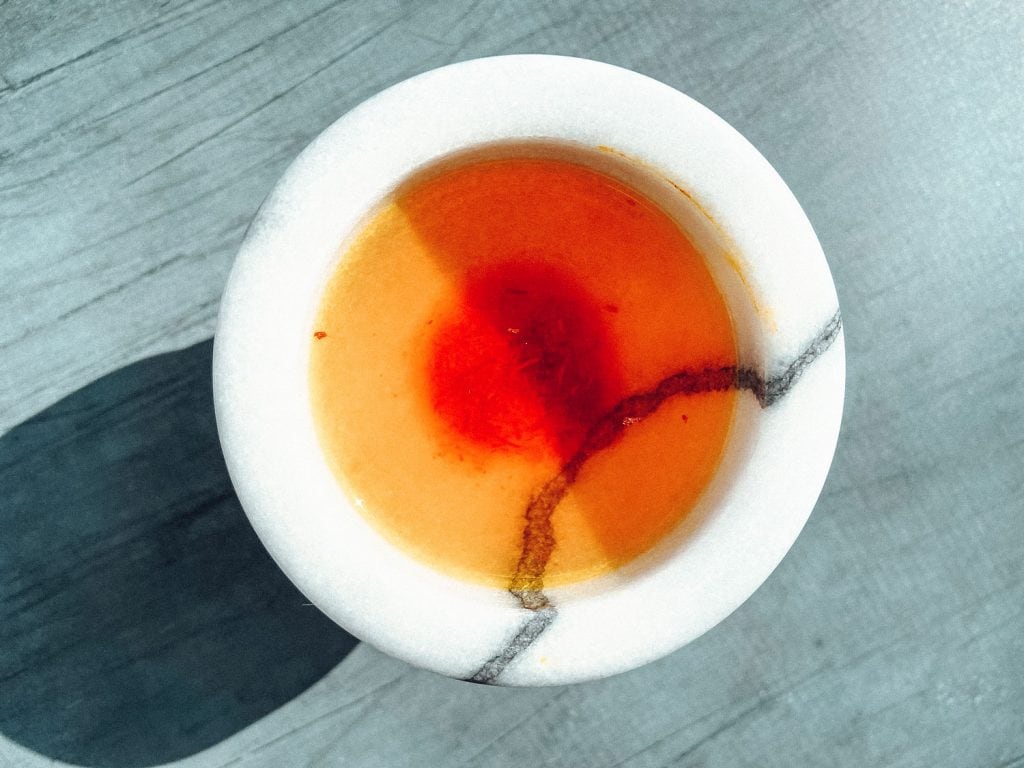

Photos by Kae Lani Palmisano
FINDING SAFFRON
To understand saffron is to understand the immense work that goes into this product. Saffron begins with the Crocus sativus flower, a small purple flower that blooms in the autumn as opposed to other flowering herbs and spices that bloom in the spring. These flowers grow from bulb-like pods called corms that can take 7 to 10 months to grow and harvest. You won’t get too many Crocus sativus flowers in the first year because one corm will only produce a few flowers. However, with every season that passes, the planted corms divide, creating clusters of cormlets that year after year will yield an exponential number of flowers.
But the flower itself isn’t saffron – it’s the dark red stigmas protruding from the flowers that is the fragrant spice the world yearns for. Each flower only produces three strands of saffron which means it takes about 150 flowers to produce just 1 gram of saffron.
“Saffron is laborious,” says Mohammad Salehi, CEO of Heray Spice, a company that sells Afghan saffron. “All those flowers have only three red threads, and they’re all hand-picked. You have to pick every single little string from inside the flower.”
Salehi immigrated from Afghanistan to Chicago at the end of 2013 and by April of 2017 he started Heray Spice. What started out as connecting a few Afghani saffron farmers to chefs in Chicago has evolved into a spice coop of about 30 family farmers that are providing saffron to over 100 chefs working at hotels and restaurants across the country, as well as home chefs ordering the product online.
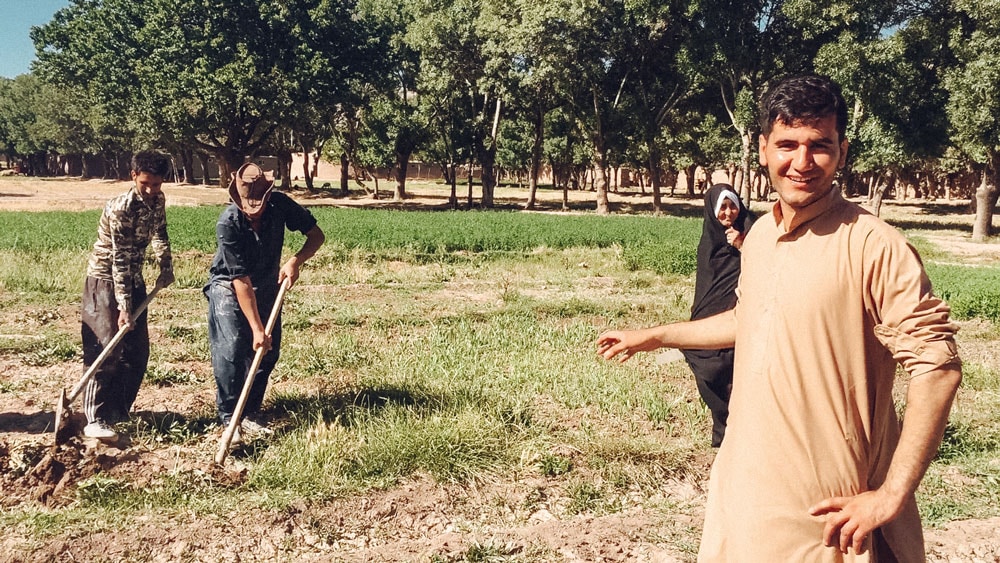

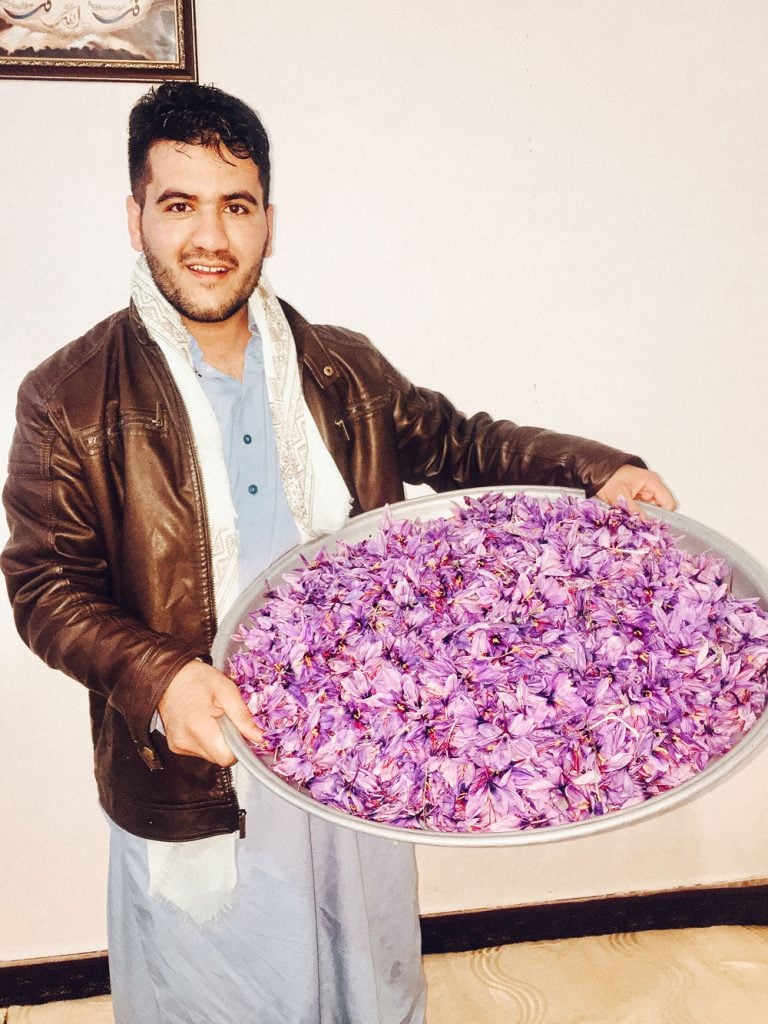
Photos by Heray Spices
But Salehi’s business model isn’t just about sourcing high quality saffron. “One of the biggest aspects of my company is helping farmers in Afghanistan. Because farmers need a lot of attention here. They are the ones who get the least amount of money in the cycle,” says Salehi. “We teach farmers how to cultivate saffron in a better way. We give them sanitization products, soap, gloves, anything they need for the process.”
In addition to providing farmers with what they need to cultivate and harvest saffron, Heray Spice also pays farmers competitive rates per kilo and also gives 10% of what they make back to building schools for Afghan children as well as other educational charities. Salehi believes that reinvesting in the community of Afghani farmers creates a sustainable system because when the farmers thrive, so does the saffron.
But buyer beware, because, according to Salehi, the market is flooded with fake saffron. Selling bootleg saffron or saffron cut with other products is a tale as old as time. In medieval Europe, saffron was stretched with sandalwood and, in some cases, safflower was used as a replacement. According to Food in Medieval Times by Melitta Weiss Adamson, gold dust, which at times was valued less than some spices, was occasionally added to saffron to bring it up to the right weight. The problem of manipulating the weight of spices and peddling cheap substitutes was so prolific that strict laws were put into place. In Nuremberg, where spices and goods were inspected and sold throughout Europe, they passed the Safranschou, a law that governed the purity of saffron. Anyone who violated the law could face fines, imprisonment, and even death.
Rules for saffron are a lot less strict these days, but the problem with selling impure saffron is still prevalent. To this day, there are still cases where safflower is sold as saffron or added to saffron to bulk it out. There are also more extreme claims circulating that horse hairs, corn silks, and shredded paper are dyed and added to saffron to make the product stretch. In 2019, thousands of pounds of adulterated saffron – worth upwards of £750,000 – was seized from a Spanish factory.
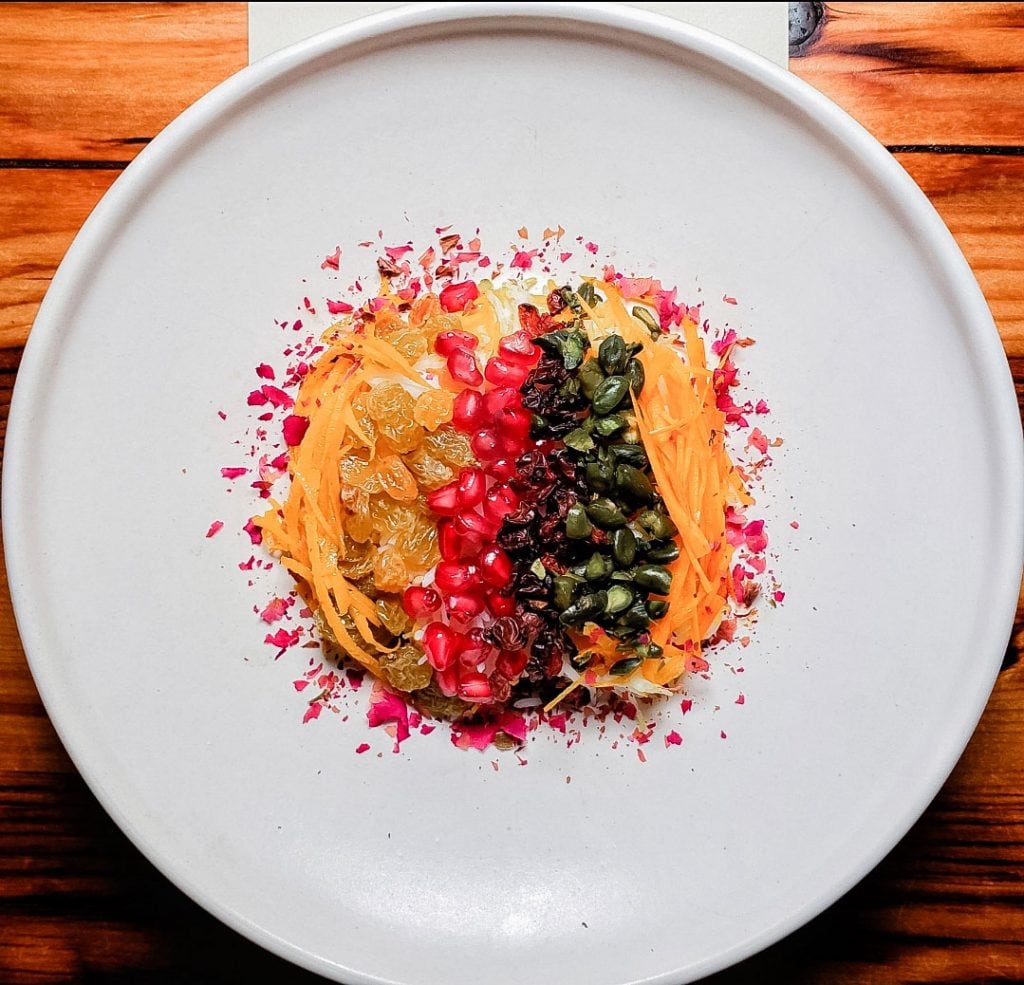

Photos by Ryan Kober (left) and Kae Lani Palmisano (right)
To see if you’ve got real saffron in your pantry, Salehi recommends doing a simple water test. “Boil water and put the saffron in the hot water. If it’s real, it won’t lose its red color. If it’s fake, after a few minutes the food coloring will come off the strings and the threads will be white. If it’s safflower, it will begin to bubble,” says Salehi.
The smell and taste are also reliable ways to test your saffron. “Saffron will give you a woody, natural smell. And the flavor should be a little bit sour and sweet,” says Salehi. “Fake saffron will give you a chemical smell because it’s got food coloring. And it will taste a little like tobacco.”
When you’re shopping for high quality saffron, Jamshidi recommends examining the appearance of the product. “The thickness of the crocus is important,” says Jamshidi. “Look for not thin, hairy strands, but thicker strands. Almost like tiny, dried pieces of stick. On either end of the saffron, there’s a thinness and off coloring of the red that’s yellow or off-white. You want to buy a saffron that has the least amount of that.”
Communication is key when searching for saffron, and not just communication with the company you’re purchasing from. Salehi believes spice purveyors should be talking to farmers, and urges buyers to research what kinds of relationships companies have with their providers. “There are lots of small spice companies who are actually talking to farmers,” says Salhei. “When buying saffron or any other spice, think about the money you’re giving to the spice. Is it affecting a big corporation or is it touching the lives of farmers?”
Related Articles
-
 Travel & Culture March 16, 2020 | 6 min read Significance of Sustenance: Burlington I grew up in the shadow of the slopes in the Pocono Mountains, but the icy Pennsylvania conditions made skiing decidedly unfun for fall-prone little-ol’ me.
Travel & Culture March 16, 2020 | 6 min read Significance of Sustenance: Burlington I grew up in the shadow of the slopes in the Pocono Mountains, but the icy Pennsylvania conditions made skiing decidedly unfun for fall-prone little-ol’ me. -
 Travel & Culture April 02, 2020 | 8 min read A Brooklyn Pizzeria Fights Through COVID-19 COVID-19 hit the city like a slow-moving hurricane. We knew it was coming, but we were still in shock. Everything was uncertain.
Travel & Culture April 02, 2020 | 8 min read A Brooklyn Pizzeria Fights Through COVID-19 COVID-19 hit the city like a slow-moving hurricane. We knew it was coming, but we were still in shock. Everything was uncertain. -
 Travel & Culture June 23, 2020 | 6 min read Distinctive Process: Maori Hangi Steaming geothermal pools set against a vivid blue sky, in the middle of lush natural surroundings and a day spent soaking up indigenous Maori culture.
Travel & Culture June 23, 2020 | 6 min read Distinctive Process: Maori Hangi Steaming geothermal pools set against a vivid blue sky, in the middle of lush natural surroundings and a day spent soaking up indigenous Maori culture.
